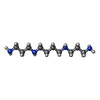[English] 日本語
 Yorodumi
Yorodumi- PDB-8g2n: Crystal structure of Tetrahymena thermophila G-rich DNA with nove... -
+ Open data
Open data
- Basic information
Basic information
| Entry | Database: PDB / ID: 8g2n | ||||||
|---|---|---|---|---|---|---|---|
| Title | Crystal structure of Tetrahymena thermophila G-rich DNA with novel ligand PyDH2 | ||||||
 Components Components | G-rich DNA | ||||||
 Keywords Keywords | DNA / G-quadruplex DNA / ligand intercalation / four tetrads | ||||||
| Function / homology | : / SPERMINE / : / DNA / DNA (> 10) Function and homology information Function and homology information | ||||||
| Biological species |  | ||||||
| Method |  X-RAY DIFFRACTION / X-RAY DIFFRACTION /  SYNCHROTRON / SYNCHROTRON /  MOLECULAR REPLACEMENT / Resolution: 1.33 Å MOLECULAR REPLACEMENT / Resolution: 1.33 Å | ||||||
 Authors Authors | Martin, K.N. / Yatsunyk, L.A. | ||||||
| Funding support |  United States, 1items United States, 1items
| ||||||
 Citation Citation |  Journal: To be published Journal: To be publishedTitle: Crystal structure of Tetrahymena thermophila G-rich DNA with novel ligand PyDH2 Authors: Martin, K.N. / Yatsunyk, L.A. | ||||||
| History |
|
- Structure visualization
Structure visualization
| Structure viewer | Molecule:  Molmil Molmil Jmol/JSmol Jmol/JSmol |
|---|
- Downloads & links
Downloads & links
- Download
Download
| PDBx/mmCIF format |  8g2n.cif.gz 8g2n.cif.gz | 62.4 KB | Display |  PDBx/mmCIF format PDBx/mmCIF format |
|---|---|---|---|---|
| PDB format |  pdb8g2n.ent.gz pdb8g2n.ent.gz | 40.1 KB | Display |  PDB format PDB format |
| PDBx/mmJSON format |  8g2n.json.gz 8g2n.json.gz | Tree view |  PDBx/mmJSON format PDBx/mmJSON format | |
| Others |  Other downloads Other downloads |
-Validation report
| Summary document |  8g2n_validation.pdf.gz 8g2n_validation.pdf.gz | 673.5 KB | Display |  wwPDB validaton report wwPDB validaton report |
|---|---|---|---|---|
| Full document |  8g2n_full_validation.pdf.gz 8g2n_full_validation.pdf.gz | 674.1 KB | Display | |
| Data in XML |  8g2n_validation.xml.gz 8g2n_validation.xml.gz | 4.1 KB | Display | |
| Data in CIF |  8g2n_validation.cif.gz 8g2n_validation.cif.gz | 5.5 KB | Display | |
| Arichive directory |  https://data.pdbj.org/pub/pdb/validation_reports/g2/8g2n https://data.pdbj.org/pub/pdb/validation_reports/g2/8g2n ftp://data.pdbj.org/pub/pdb/validation_reports/g2/8g2n ftp://data.pdbj.org/pub/pdb/validation_reports/g2/8g2n | HTTPS FTP |
-Related structure data
| Similar structure data | Similarity search - Function & homology  F&H Search F&H Search |
|---|
- Links
Links
- Assembly
Assembly
| Deposited unit | 
| ||||||||||||
|---|---|---|---|---|---|---|---|---|---|---|---|---|---|
| 1 |
| ||||||||||||
| Unit cell |
| ||||||||||||
| Components on special symmetry positions |
|
- Components
Components
-DNA chain , 1 types, 1 molecules A
| #1: DNA chain | Mass: 7985.084 Da / Num. of mol.: 1 / Source method: obtained synthetically / Source: (synth.)  |
|---|
-Non-polymers , 5 types, 69 molecules 






| #2: Chemical | ChemComp-YSQ / Mass: 503.555 Da / Num. of mol.: 1 / Source method: obtained synthetically / Formula: C29H25N7O2 / Feature type: SUBJECT OF INVESTIGATION | ||||
|---|---|---|---|---|---|
| #3: Chemical | ChemComp-MG / | ||||
| #4: Chemical | | #5: Chemical | ChemComp-SPM / | #6: Water | ChemComp-HOH / | |
-Details
| Has ligand of interest | Y |
|---|
-Experimental details
-Experiment
| Experiment | Method:  X-RAY DIFFRACTION / Number of used crystals: 1 X-RAY DIFFRACTION / Number of used crystals: 1 |
|---|
- Sample preparation
Sample preparation
| Crystal | Density Matthews: 2.54 Å3/Da / Density % sol: 51.6 % / Description: Flat golden rhombus |
|---|---|
| Crystal grow | Temperature: 295 K / Method: vapor diffusion, hanging drop / pH: 6.5 Details: 0.02 M MgCl2, 0.165 M KCl, 0.04 M sodium cacodylate pH 6.5, 0.012 M spermine tetrahydrochloride, 39% (+/-)-2-Methyl-2,4-pentanediol (MPD) |
-Data collection
| Diffraction | Mean temperature: 80 K / Serial crystal experiment: N |
|---|---|
| Diffraction source | Source:  SYNCHROTRON / Site: SYNCHROTRON / Site:  APS APS  / Beamline: 24-ID-E / Wavelength: 0.8856 Å / Beamline: 24-ID-E / Wavelength: 0.8856 Å |
| Detector | Type: DECTRIS EIGER X 16M / Detector: PIXEL / Date: Dec 10, 2022 |
| Radiation | Protocol: SINGLE WAVELENGTH / Monochromatic (M) / Laue (L): M / Scattering type: x-ray |
| Radiation wavelength | Wavelength: 0.8856 Å / Relative weight: 1 |
| Reflection | Resolution: 1.33→29.78 Å / Num. obs: 18082 / % possible obs: 97.4 % / Redundancy: 5.1 % / Biso Wilson estimate: 24.32 Å2 / CC1/2: 0.999 / Rmerge(I) obs: 0.026 / Net I/σ(I): 24.7 |
| Reflection shell | Resolution: 1.33→1.35 Å / Redundancy: 5.1 % / Num. unique obs: 818 / CC1/2: 0.758 / % possible all: 92.1 |
- Processing
Processing
| Software |
| |||||||||||||||||||||||||||||||||||||||||||||||||
|---|---|---|---|---|---|---|---|---|---|---|---|---|---|---|---|---|---|---|---|---|---|---|---|---|---|---|---|---|---|---|---|---|---|---|---|---|---|---|---|---|---|---|---|---|---|---|---|---|---|---|
| Refinement | Method to determine structure:  MOLECULAR REPLACEMENT / Resolution: 1.33→29.78 Å / SU ML: 0.1461 / Cross valid method: FREE R-VALUE / σ(F): 1.36 / Phase error: 27.1518 MOLECULAR REPLACEMENT / Resolution: 1.33→29.78 Å / SU ML: 0.1461 / Cross valid method: FREE R-VALUE / σ(F): 1.36 / Phase error: 27.1518 Stereochemistry target values: GeoStd + Monomer Library + CDL v1.2
| |||||||||||||||||||||||||||||||||||||||||||||||||
| Solvent computation | Shrinkage radii: 0.9 Å / VDW probe radii: 1.11 Å / Solvent model: FLAT BULK SOLVENT MODEL | |||||||||||||||||||||||||||||||||||||||||||||||||
| Displacement parameters | Biso mean: 31.46 Å2 | |||||||||||||||||||||||||||||||||||||||||||||||||
| Refinement step | Cycle: LAST / Resolution: 1.33→29.78 Å
| |||||||||||||||||||||||||||||||||||||||||||||||||
| Refine LS restraints |
| |||||||||||||||||||||||||||||||||||||||||||||||||
| LS refinement shell |
|
 Movie
Movie Controller
Controller


 PDBj
PDBj










































